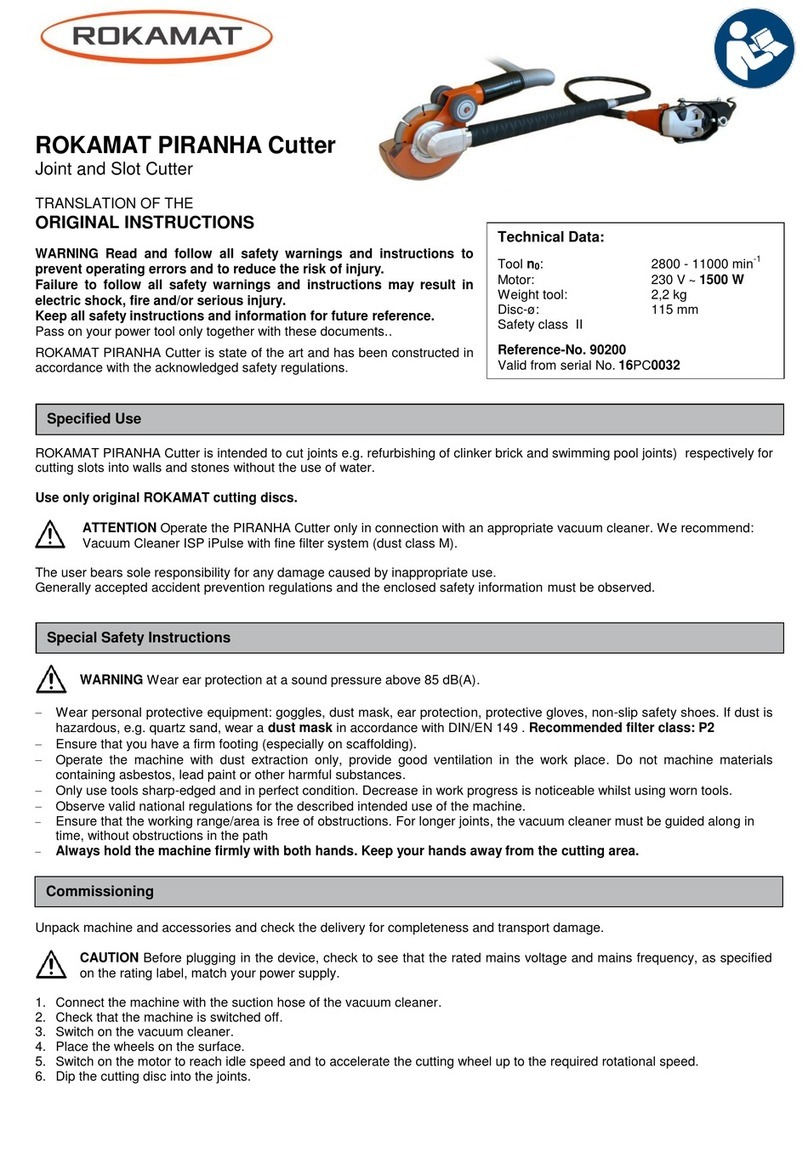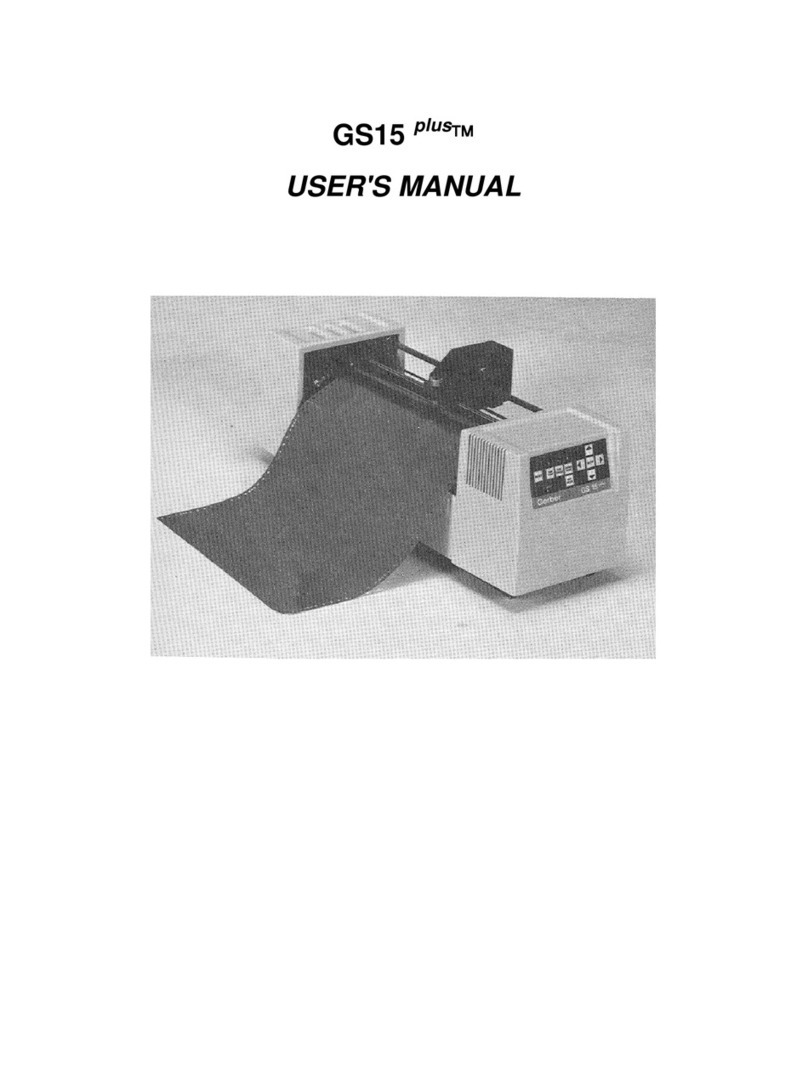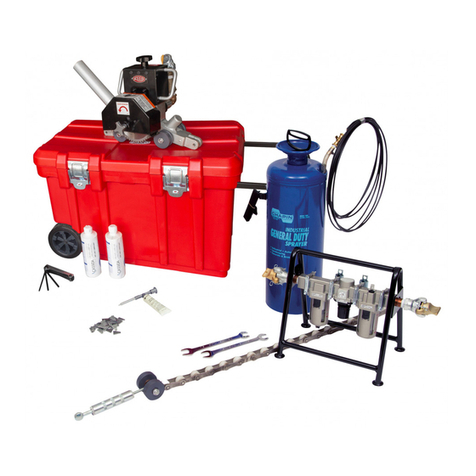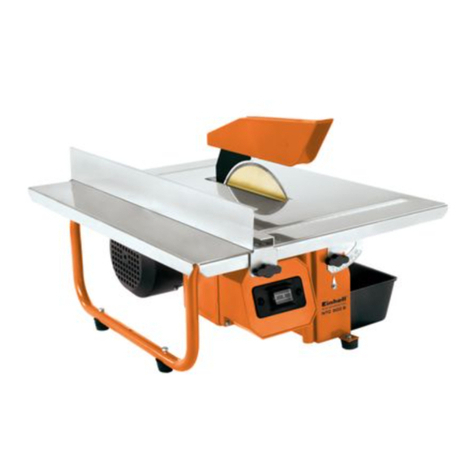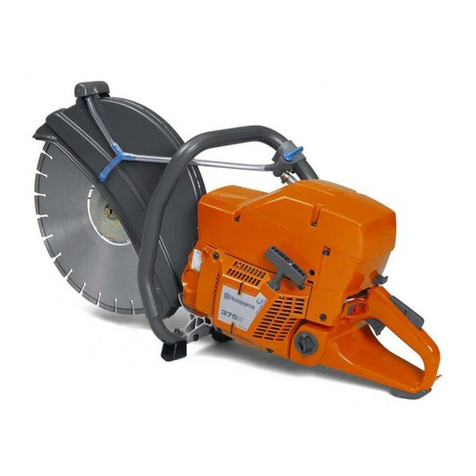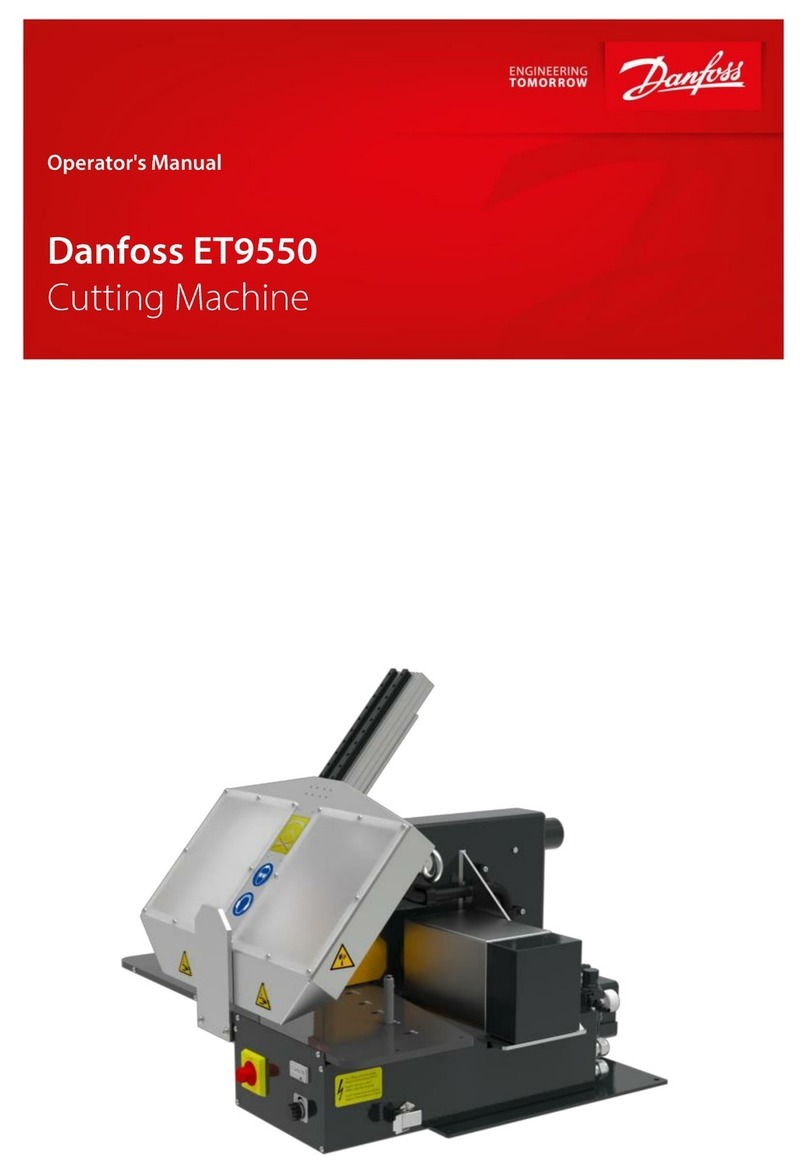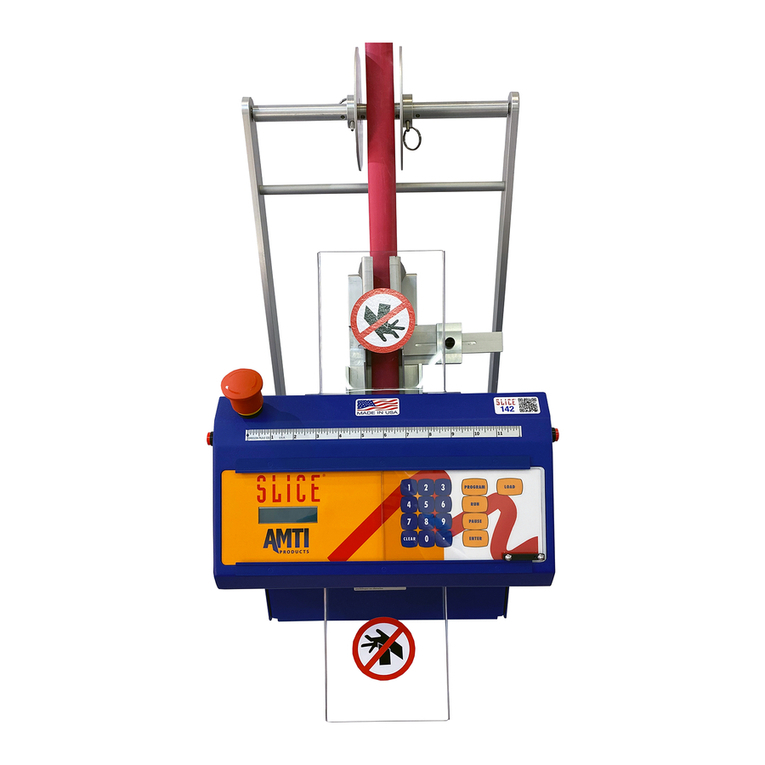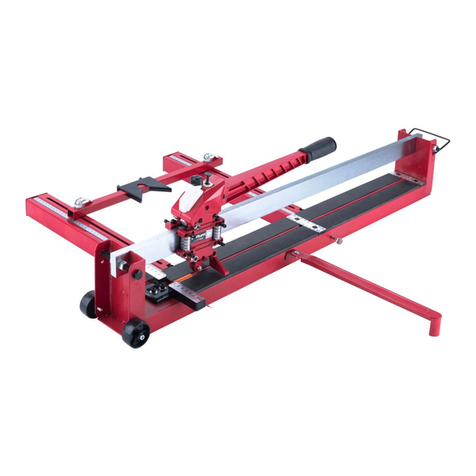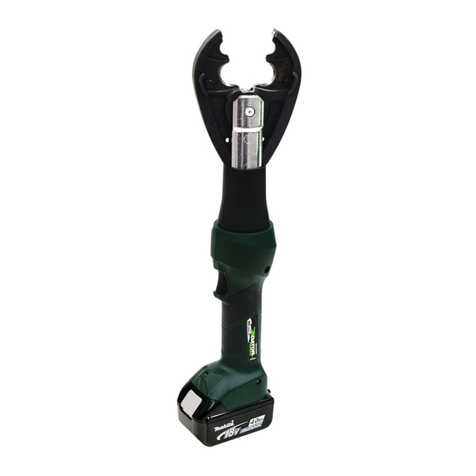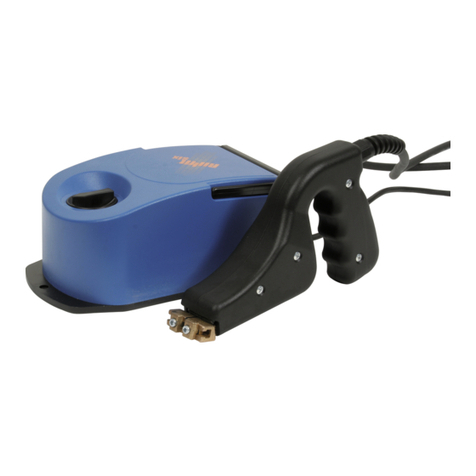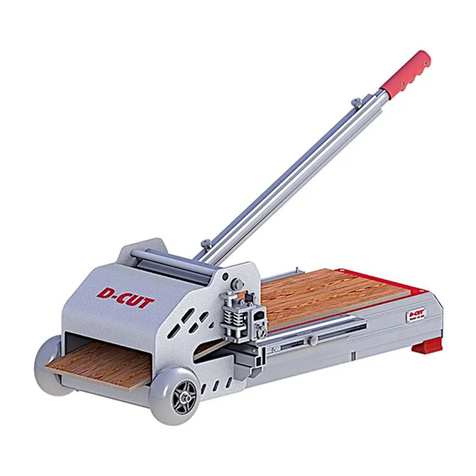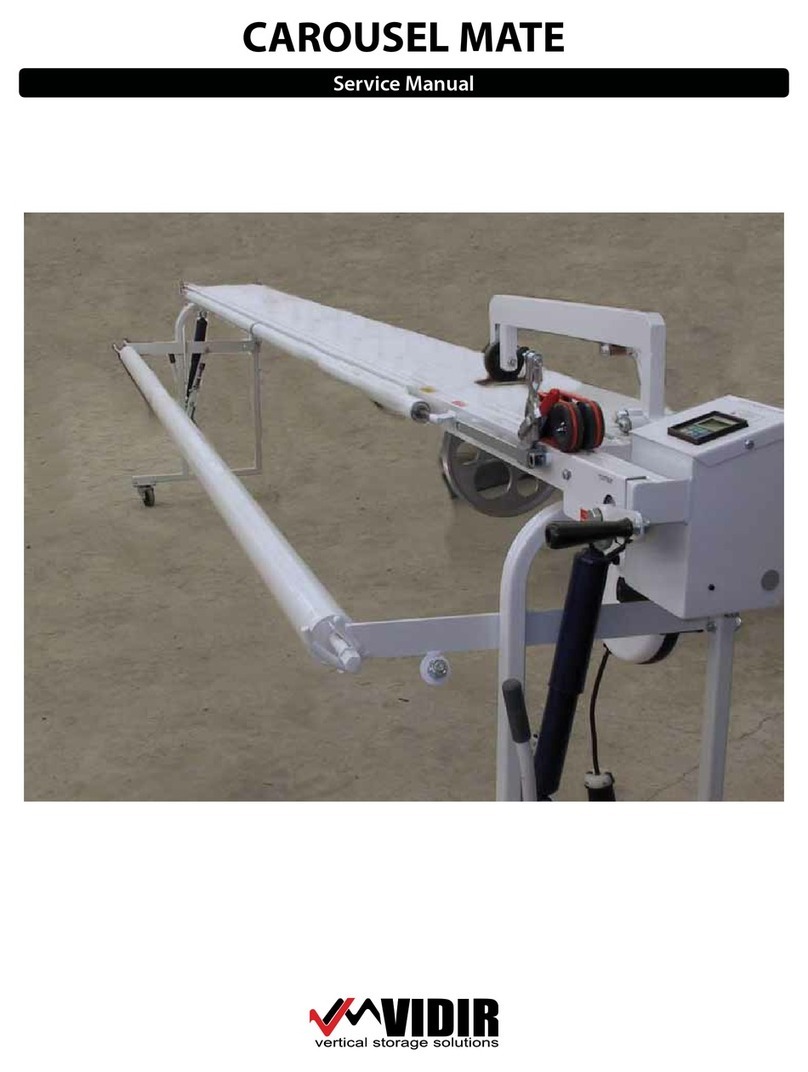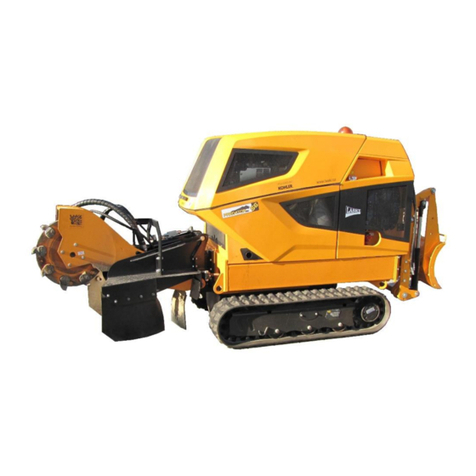ROKAMAT 90200 User manual

1) Rokamat Piranha Cutter (21PC0165)
2) 2014/30/EU, 2006/42/EG, 2012/19/EU, 2011/65/EU,
2001/95/EG, EG No. 1907/2006
3) EN 60745-1:2009/A11:2010, EN 60745-2-22:2011 + A11:2013;
EN ISO 12100:2010-11
4) Kammerer GmbH, An der B 10, 75196 Remchingen
Remchingen, 20.12.2021
Beate Kammerer
Head of Technical Documentation
EN
Original Instructions
3
Piranha Cutter
Art.-Nr. 90200
© Kammerer GmbH. Printed in Germany. Abbildungen unverbindlich.
Technische Änderungen vorbehalten. BA_Piranha Cutter_EN_001
ROKAMAT
Kammerer GmbH
An der B 10
75196 Remchingen
Deutschland
www.rokamat.com

Piranha Cutter
2
[1]
3-1
1-1
1-3
1-5
1-7
1-6
1-8
1-10
I
0
[4]
[2]
[3]
1-2
[5]
[7]
7-4
7-2
7-1
7-7
2-1
5-2
5-3
7-5
1-4
1-9
5-4
5-5
5-1
5-6
7-3
7-3
7-6
[6]
6-1
6-2
6-4
6-3
Ø115 mm
Ø125 mm
2,2 mm
5,5 mm
9,0 mm
2,4 mm
5,4 mm
8,5 mm

Piranha Cutter en English
3
1. Symbols ......................................................................... 3
2. Safety Instructions .................................................... 3
3. Intended Use ................................................................4
4. Technical Specifications ..........................................4
5. Device Components...................................................4
6. Commissioning............................................................ 5
7. Instructions for Use................................................... 5
8. Working with the Power Tool ................................ 5
9. Maintenance and Care.............................................. 5
10. Spare Parts and Accessories.................................. 6
11. Environmental Protection....................................... 6
12. Declaration of Conformity....................................... 6
13. Troubleshooting ......................................................... 6
For your own protection and for the protec-
tion of your power tool, pay attention to all
parts of the text that are marked with this
symbol!
Risk of electric shock!
Read operating instructions and safety no-
tices! *)
Wear protective goggles! *)
Wear ear protection!
Wear a dust mask!
Disconnect from the power supply!
Two-hand operation *)
Do not dispose of as domestic waste! *)
Important advice/information
Safety class I *)
~ Alternating current *)
Confirms the conformity of the power tool
with the directives of the European Com-
munity. *)
Confirms the conformity of the power tool
with UK legislation. *)
*)These symbols are (also) on the device.
For your safety
Read all safety warnings and instructions.
Failure to follow all safety warnings and in-
structions may result in electric shock, fire
and/or serious injury.
Do not use this power tool before you have
thoroughly read and completely understood
this Instruction Manual and the enclosed
“General Safety Instructions”.
Keep all safety instructions and information for
future reference. Pass on your power tool only to-
gether with these documents.
Please also observe the relevant national industrial
safety regulations.
Special Safety Instructions
Safety Warnings for wall chaser:
a] The guard provided with the tool must be se-
curely attached to the power tool and posi-
tioned for maximum safety, so the least
amount of wheel is exposed towards the op-
erator. Position yourself and bystanders
away from the plane of the rotating wheel.
The guard helps to protect operator from bro-
ken wheel fragments and accidental contact
with wheel.
b] Use only diamond cut-off wheels for your
power tool. Just because an accessory can be
attached to your power tool, it does not assure
safe operation.
c] The rated speed of the accessory must be at
least equal to the maximum speed marked on
the power tool. Accessories running faster
than their rated speed can break and fly apart.
d] Wheels must be used only for recommended
applications. For example: do not grind with
the side of cut-off wheel. Abrasive cut-off
wheels are intended for peripheral grinding,
side forces applied to these wheels may cause
them to shatter.
e] Always use undamaged wheel flanges that
are of correct diameter for your selected
wheel. Proper wheel flanges support the
wheel thus reducing the possibility of wheel
breakage.
f] The outside diameter and the thickness of
your accessory must be within the capacity
rating of your power tool. Incorrectly sized ac-
cessories cannot be adequately guarded or
controlled.
g] The arbour size of wheels and flanges must
properly fit the spindle of the power tool.
Wheels and flanges with arbour holes that do
not match the mounting hardware of the power
tool will run out of balance, vibrate excessively
and may cause loss of control.
h] Do not use damaged wheels. Before each use,
inspect the wheels for chips and cracks. If
power tool or wheel is dropped, inspect for
damage or install an undamaged wheel. After
inspecting and installing the wheel, position
yourself and bystanders away from the plane
of the rotating wheel and run the power tool
at maximum no load speed for one minute.
Damaged wheels will normally break apart
during this test time.
i] Wear personal protective equipment. De-
pending on application, use face shield,
safety goggles or safety glasses. As appro-
priate, wear dust mask, hearing protectors,
gloves and shop apron capable of stopping
small abrasive or workpiece fragments. The
eye protection must be capable of stopping fly-
ing debris generated by various operations. The
dust mask or respirator must be capable of fil-
trating particles generated by your operation.
Prolonged exposure to high intensity noise may
cause hearing loss.
j] Keep bystanders a safe distance away from
work area. Anyone entering the work area
must wear personal protective equipment.
Fragments of workpiece or of a broken wheel
may fly away and cause injury beyond immedi-
ate area of operation.
k] Hold the power tool by insulated gripping
surfaces only, when performing an operation
where the cutting accessory may contact hid-
den wiring or its own cord. Cutting accessory
contacting a “live” wire may make exposed
metal parts of the power tool “live” and could
give the operator an electric shock.
l] Position the cord clear of the spinning acces-
sory. If you lose control, the cord may be cut or
snagged and your hand or arm may be pulled
into the spinning wheel.
m] Never lay the power tool down until the ac-
cessory has come to a complete stop. The
spinning wheel may grab the surface and pull
the power tool out of your control.
n] Do not run the power tool while carrying it at
your side. Accidental contact with the spinning
accessory could snag your clothing, pulling the
accessory into your body.
o] Regularly clean the power tool’s air vents.
The motor’s fan will draw the dust inside the
housing and excessive accumulation of pow-
dered metal may cause electrical hazards.
p] Do not operate the power tool near flamma-
ble materials. Sparks could ignite these mate-
rials.
q] Do not use accessories that require liquid
coolants. Using water or other liquid coolants
may result in electrocution or shock.
Kickback and related warnings
Kickback is a sudden reaction to a pinched or
snagged rotating wheel, backing pad, brush or any
other accessory. Pinching or snagging causes rapid
stalling of the rotating accessory which in turn
causes the uncontrolled power tool to be forced in
the direction opposite of the accessory’s rotation at
the point of the binding.
For example, if an abrasive wheel is snagged or
pinched by the workpiece, the edge of the wheel
that is entering into the pinch point can dig into the
surface of the material causing the wheel to climb
out or kick out. The wheel may either jump toward
or away from the operator, depending on direction
of the wheel’s movement at the point of pinching.
Abrasive wheels may also break under these con-
ditions.
Kickback is the result of power tool misuse and/or
incorrect operating procedures or conditions and
can be avoided by taking proper precautions as
given below.
a] Maintain a firm grip on the power tool and po-
sition your body and arm to allow you to re-
sist kickback forces. Always use auxiliary
handle, if provided, for maximum control over
kickback or torque reaction during start-up.
The operator can control torque reactions or
kickback forces, if proper precautions are
taken.
1. Symbols
2. Safety Instructions
WARNING!
Contents

Piranha Cutter en English
4
b] Never place your hand near the rotating ac-
cessory. Accessory may kickback over your
hand.
.c] Do not position your body in the area where
power tool will move if kickback occurs. Kick-
back will propel the tool in direction opposite to
the wheel’s movement at the point of snagging.
d] Use special care when working corners, sharp
edges, etc. Avoid bouncing and snagging the
accessory. Corners, sharp edges or bouncing
have a tendency to snag the rotating accessory
and cause loss of control or kickback.
e] Do not attach a saw chain, woodcarving
blade, segmented diamond wheel with a pe-
ripheral gap greater than 10 mm or toothed
saw blade. Such blades create frequent kick-
back and loss of control over the power tool.
f] Do not “jam” the wheel or apply excessive
pressure. Do not attempt to make an exces-
sive depth of cut. Overstressing the wheel in-
creases the loading and susceptibility to twist-
ing or binding of the wheel in the cut and the
possibility of kickback or wheel breakage.
g] When wheel is binding or when interrupting a
cut for any reason, switch off the power tool
and hold the power tool motionless until the
wheel comes to a complete stop. Never at-
tempt to remove the wheel from the cut while
the wheel is in motion otherwise kickback
may occur. Investigate and take corrective ac-
tion to eliminate the cause of wheel binding.
h] Do not restart the cutting operation in the
workpiece. Let the wheel reach full speed and
carefully re-enter the cut. The wheel may
bind, walk up or kickback if the power tool is re-
started in the workpiece.
i] Support panels or any oversized workpiece to
minimize the risk of wheel pinching and kick-
back. Large workpieces tend to sag under
their own weight. Supports must be placed un-
der the workpiece near the line of cut and near
the edge of the workpiece on both sides of the
wheel.
j] Use extra caution when making a “pocket cut”
into existing walls or other blind areas. The
protruding wheel may cut gas or water pipes,
electrical wiring or objects that can cause
kickback.
Additional safety instructions
Particles generated when working with this ma-
chine may contain substances that can cause
cancer, allergic reactions, respiratory diseases,
birth defects or other propagation defects. Some of
these substances include: Lead (in paint containing
lead), mineral dust (from bricks, concrete etc.), ad-
ditives used for wood treatment (chromate, wood
preservatives), some wood types (such as oak or
beech dust), metals, asbestos.
The risk depends on for how long the user or nearby
persons are exposed to the substance.
This dust must not be allowed to enter your body.
Do the following to reduce exposure to these sub-
stances:
- Ensure good ventilation of the workplace.
- Wear appropriate protective equipment, such as
respirators able to filter microscopically small
particles.
- To protect your health, wear a suitable
protective mask.
- Always wear protective goggles to protect
against sanding hazards.
- Connect the electric power tool to a suitable ex-
traction system.
- Sweeping or blowing stirs up dust.
- Vacuum or wash the protective clothing. Do not
blow, beat or brush.
Collect the generated particles at the source, avoid
deposits in the surrounding area.
Observe the relevant guidelines for your material,
staff, application and place of application (e.g. oc-
cupational health and safety regulations, dis-
posal).
If potentially explosive or self-igniting dust is pro-
duced during sanding, the machining instructions
issued by the material manufacturer must always
be followed.
Always use an antistatic suction hose with the
power tool. A slight electric shock may cause you to
panic briefly and become distracted, which may re-
sult in an accident.
When the safety clutch responds, switch off the
machine immediately!
Do not overload the motor for a long period. Engine
noise should be regular (not wave-like). Unsteady
engine performance can be perceived acoustically.
Take a break when the machine is heated up
strongly and let it cool down again. To that let the
motor idle at top speed for some time.
Don’t bend the flexible drive shaft!
Don’t put the running motor on the ground! Dirt may
get sucked in and cause damage.
Always use original ROKAMAT abrasives. Foreign
abrasives are not suitable for the speed of the
sander and may break.
Pull the plug out of the socket before making any
adjustments, converting or servicing the machine.
Ensure sufficient cable clearance. Use only exten-
sion cables permitted for outdoor use.
Keep the carry case out of reach of children. Chil-
dren may suffocate or be strangled when playing
with the carry case.
Emission levels
NOTE! Values for the A-weighted sound pressure
level and for the total vibration values can be found
in the “Technical specifications” table at page 9.
The vibration emission level given in this infor-
mation sheet has been measured in accordance
with a standardized test and may be used to com-
pare one tool with another. It may be used for a
preliminary assessment of exposure.
CAUTION! The indicated measurements refer to
new power tools. Daily use causes the noise and vi-
bration values to change.
The declared vibration emission level represents
the main applications of the tool. However, if the
tool is used for different applications, with differ-
ent accessories or poorly maintained, the vibration
emission may differ. This may significantly in-
crease the exposure level over the total working
period. However, if the tool is used for different ap-
plications, with different accessories or poorly
maintained, the vibration emission may differ. This
may significantly decrease the exposure level over
the total working period.
CAUTION! The noise produced during work
may damage your hearing.
Wear ear protection!
The hand-guided wall chaser Piranha Cutter is in-
tended for:
•Milling of clinker joints
•Milling of swimming pool joints
•Milling of grooves such as cable slots in ma-
sonry and stone material as well as concrete
During operation, the power tool must rest firmly
on the guiding wheels. At all times, working must
be carried out without using or applying any water.
The Piranha Cutter is only intended for use with
Rokamat diamond cutting discs and accessories.
The instructions for the correct use of the tool must
be observed. The tool may only be operated in com-
bination with a suitable vacuum cleaner.
Only sufficiently qualified and trained personnel is
allowed to work with the grinder.
The intended use includes the observance of the
operating instructions, in particular the safety in-
structions and the observance of generally recog-
nized accident prevention regulations.
Wall chaser Piranha Cutter
Item no. 90200
Rated voltage
230 V AC
Frequency
50 Hz
Power
1500 W
No-load speed n0
2600-9100 min-1
Threaded spindle
M12x1,5
Tool diameter
115/125 mm
Maximum number of dia-
mond cutting discs
3
Tool holder weight
1,7 kg
Total weight
5,8 kg
Dimension compact
(LxHxW)
800 x 180 x
430 mm
Cable length
5,0 m
Safety class
I /
A-weighted sound pressure level (see cap. 2
“Emission levels“):
Sound pressure level LpA
102 dB(A)
Sound power level LWA
113 dB(A)
Uncertainty KpA, KWA
3,0 dB
Total vibration value (see cap. 2 “Emission lev-
els“):
Emmission value ah
6,4 m/s2
Uncertainty K
1,5 m/s2
The specified illustrations can be found in fig. [1]
on page 2 of the operating instructions.
1-1 Guard
1-2 Handhold (Gripping surface)
1-3 Slide switch
1-4 Carabiner
1-5 Belt
4. Technical Specifications
5. Device Components
3. Intended Use

Piranha Cutter en English
5
1-6 Motor (with gripping surface)
1-7 Mains cable
1-8 Flexible drive shaft
1-9 Intake socket
1-10 Guide wheels
Unauthorised voltage or frequency!
Risk of accident!
The mains voltage and the frequency of the
power source must correspond with the specifi-
cations on the machine's name plate.
Only connect the tool to a grounded power sup-
ply.
Connecting the dust extraction system [2]
Push the suction hose [2-1] onto the intake socket
[1-9]. Check for correct fit! If necessary, use a suit-
able adapter. See also chapter 7.
Motor mounting
The motor [1-6] is not allowed to be placed on the
floor during operation, but must be hooked in the
carabiner [1-4] of the provided belt [1-5] (resp.
shoulder belt).
Switching the electric power tool on and off
[4]
Switching on: Push the sliding switch [1-3] for-
ward. For continuous activation, now tilt
downwards until it engages.
Switching off: Press the rear end of the slide
switch [1-3] and release it.
Risk of injury, electric shock!
Always pull the mains plug out of the socket be-
fore performing any type of work on the ma-
chine!
Attaching and changing the diamond cut-
ting discs [5]
- Put the diamond cutting discs [5-2] on the spindle
thread [5-3]. Align the direction of rotation ar-
rows on the diamond cutting disc [5-2] and the
machine.
- Fit the spacer discs [5-6], then fit the other dia-
mond cutting disc(s) [5-2] and the clamping
flange with undercut facing downwards [5-5].
- Tighten the clamping flange [5-5] firmly clock-
wise with the face spanner [5-4] while locking
the spindle [5-3] with the hexagon socket span-
ner SW5 [5-1].
- Removing in reverse order.
Adjusting the groove width (the distance
between the two diamond wheels) [6]
When using spacer discs, pay attention to the
correct thickness:
For diamond cutting discs 115 mm →2,0 mm
For diamond cutting discs 125 mm →1,5 mm
Adjust the groove width by changing the number of
diamond cutting discs and space discs as indicated
in the overview.
To the illustrations in fig. [6]:
6-1 Diamond cutting disc Ø115 mm
6-2 Space discs 22,2x35x2(Item no. 18440)
6-3 Diamond cutting disc Ø125 mm
6-4 Space discs 22,2x35x1,5 (Item no. 18441)
Adjusting the speed [3]
Set the recommended speed at the thumbwheel
[3-1]. (small number = low speed; large number =
high speed).
Dust extraction
Health hazard posed by dust!
Always work with an extractor. Comply with na-
tional regulations.
The dust extraction system offered on our website
is adapted to the quantity of dust generated and
permanently ensure the necessary suction power.
Always use an antistatic suction hose! This
helps reduce the electrostatic charge.
First keep the diamond wheels without mak-
ing any contact with a workpiece. Then turn the
tool on and wait until the diamond wheels attain
full speed.
Use this tool for straight line cutting only! Cut-
ting curves can cause stress cracks or fragmen-
tation of the diamond wheels resulting in possi-
ble injury to persons in the vicinity.
1. Attach diamond cutting discs.
2. Connect dust extraction system.
3. Attach motor to (shoulder) belt.
4. Insert mains plug.
5. Set required speed.
6. Switch on dust extraction system.
7. Hold the tool firmly with both hands.
8. Switch on the device.
9. Place the wall chaser with both guide rollers
and then plunge it into the wall/joint to the de-
sired depth.
10. Pull the tool slowly toward you –not push
away from you!
11. Remove the remaining portion between the
two blade passages by other appropriate tools.
After finishing work
Once you have finished the grinding work, set
the power tool down.
After operation, always switch off the tool and
wait until the diamond wheels come to a com-
plete stop before putting the tool down.
Risk of injury, electric shock!
Always disconnect the mains plug from the
socket before performing maintenance work on
the machine!
Repairs may be carried out by an authorized cus-
tomer service center only!
Repairs to electrical tools must be carried out by
qualified electricians only.
Check the plug and the cable regularly and should
either become damaged, in order to avoid a haz-
ard, have them replaced by an authorized custom-
er service center.
During the warranty period do not loosen the
screws on the housing. Non-compliance will deem
the guarantee obligations of the manufacturer null
and void.
Remove dust from the motor regularly
It is possible that particles deposit inside the power
tool during operation. This impairs the cooling of
the power tool. Conductive build-up can impair the
protective insulation of the power tool and cause
electrical hazards.
The power tool should be cleaned regularly, often
and thoroughly through all front and rear air vents
using a vacuum cleaner or by blowing in dry air.
Prior to this operation, separate the power tool
from the power source and wear protective glasses
and dust mask.
Replacement of the flexible drive shaft [7]
Disassembling: On the motor side, press in the
press button [7-2] in the borehole [7-1] with a tool
(e.g. screwdriver) and pull out the protective hose
[7-3]. Now the shaft core [7-4] can be replaced.
To replace the protective hose [7-3], it must also be
loosened on the side of the tool holder. To do this,
remove the plastic plug [7-7] and turn the protec-
tive hose [7-3] until the press button [7-5] is visible
in the borehole [7-6]. Press this in with a tool (e.g.
screwdriver) and pull out the protective hose [7-3].
Mounting: In reverse order. Make sure that the
shaft core [7-4] is threaded into the square in each
case.
Handling and storage
Operation
Temperature range: +5° C to +50° C
Humidity: ≤ 85 %, non-condensing
Climate: dry
Before switching on the power tool: Unpack
power tool and accessories and check that no
parts are missing or damaged.
The two boreholes for the push button at the
drive shaft serve as length adjustment between
shaft core and protective hose. The shaft core
should be freely movable in length and must not
get compressed!
6. Commissioning
7. Instructions for Use
WARNING!
WARNING!
9. Maintenance and Care
WARNING!
WARNING!
CAUTION!
ADVICE!
8. Working with the Power Tool
CAUTION!
CAUTION!
CAUTION!
CAUTION!

Piranha Cutter en English
6
Transport and storage
Temperature range: -5° C to +55° C
Humidity: 0 % to 70 %
Climate: dry, roofed, dew protected
Other accessories, in particular insertion tools, can
be found in the manufacturer’s catalogues. Ex-
ploded drawings and spare-part lists can be found
on our homepage: www.rokamat.com.
Use only original ROKAMAT spare parts and work
tools!
The generated grinding dust may contain harmful
substances. Dispose appropriately.
Observe national regulations on environmentally
compatible disposal and on the recycling of dis-
used machines, packaging and accessories.
For Great Britain and EU countries: Never
dispose of power tools in your household
waste! In accordance with WEEE relating
for electrical and electronic waste and im-
plementation of national law, used electri-
cal tools must be collected separately and
disposed of in an environmentally friendly
manner at recycling centers.
Separate the motor from the rest of the
machine before disposal. Make used tools
unusable by removing the mains cable.
Please ask your dealer about disposal options!
It is expressly declared that the cut-off machine
(wall chaser) listed on the first page under 1) from
the serial number indicated onwards complies with
all relevant provisions of the directives or regula-
tions listed in 2) and that the harmonized stand-
ards listed in 3) have been applied. The technical
documentation is available from the authorized
documentation agent named in 4).
Problem
Possible causes
Remedy
Motor runs, but the sup-
porting plate does not ro-
tate.
Shaft core broken.
Exchange shaft core.
The electronic signal dis-
play [3-1] lights up and
the load speed decreases.
There is too much load on the
machine.
Run the machine in idling until the
electronics signal indicator switches
off.
The machine does not
start. The electronic sig-
nal display [3-1] flashes.
The restart protection is active. If
the mains plug is inserted with
the machine switched on, or if the
power supply is restored follow-
ing an interruption, the machine
does not start up.
Switch the machine off and on again.
Motor power fluctuates.
Carbon brushes worn.
Replace carbon brushes.
Piranha Cutter not work-
ing.
Cable break.
Replace mains plug.
Interruption to power supply.
Switch the power tool off and on
again.
Piranha Cutter does not
run smoothly in the work-
piece.
Hard masonry or hard mortar.
Reduce the speed.
Particles between cutting discs.
Remove the particles.
Incorrect groove width selected.
Adjust groove width.
Excessive material re-
moved from workpiece.
Speed to high.
Reduce the speed.
Electrostatic charge.
Machine not grounded.
Use antistatic suction hose with suit-
able vacuum cleaner.
Extraction power is insuf-
ficient.
Filter element on the dust extrac-
tion system is blocked/clogged.
Clean the filter element regularly.
Disposal bag inserted incorrectly.
Installing the disposal bag correctly.
The suction power on the dust
extraction system is too low.
Adjust the suction power to a higher
setting.
Speed too high.
Reduce speed.
Suction hose blocked or kinked.
Remove blockage and straighten
hose.
Disposal bag full.
Dispose of the bag.
Guard is damaged.
Replace guard.
10. Spare Parts and Accessories
11. Environmental Protection
12. Declaration of Conformity
13. Troubleshooting
If problems other than those listed occur, please contact your ROKAMAT service workshop or your local
specialist.
ADVICE!
Table of contents
Other ROKAMAT Cutter manuals
